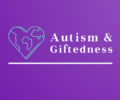Take our 59 question Autism and Giftedness test to see the extent of your autistic and gifted traits
AUTISMANDGIFTEDNESS.ORG aims to centralize clear and reliable information on autism and giftedness, two areas that can sometimes be easily confused. Our goal is to help individuals and families understand the differences and similarities between these two traits, and how they may sometimes overlap.
WHAT IS AUTISM?
Autistic people may act in a different way to other people. They may:
- find it hard to communicate and interact with other people
- find it hard to understand how other people think or feel
- find things like bright lights or loud noises overwhelming, stressful or uncomfortable
- get anxious or upset about unfamiliar situations and social events
- take longer to understand information
- do or think the same things over and over
Being autistic does not mean you have an illness or disease. It means your brain works in a different way from other people. It’s something you’re born with. Signs of autism might be noticed when you’re very young, or not until you’re older. If you’re autistic, you’re autistic your whole life. Autism is not a medical condition with treatments or a “cure”. But some people need support to help them with certain things.
Autism is a spectrum. This means everybody with autism is different. Some autistic people need little or no support. Others may need help from a parent or carer every day.
Source: National Health Institute (NHS), UK – What is Autism?
WHAT IS GIFTEDNESS?
Many gifted children share common gifted characteristics and traits, such as:
- Advanced thinking and comprehension above their age peers
- Emotional intensity at a young age
- Heightened sense of self awareness
- Highly developed curiosity
- Excellent memory
Giftedness is not considered a disability, although some gifted students may also have learning disabilities such as dyslexia, ADHD, or autism disorder. These students are known as twice-exceptional students.
The majority of the population will fall within an IQ of 85 – 115. The mean, or average, IQ is 100. A gifted child’s IQ will fall within these ranges:
- Mildly gifted: 115 to 130
- Moderately gifted: 130 to 145
- Highly gifted: 145 to 160
- Profoundly gifted: 160 or higher
Source: Davidson Institute – What is Giftedness?
HOW ARE AUTISM AND GIFTEDNESS SIMILAR?
The following table demonstrates how many autistic traits can overlap or be confused with gifted traits, according to the Davidson Institute.
| Signs of Giftedness (Taken from NAGC & the Davidson Institute) | Signs of Autism Spectrum Disorder (Taken from the CDC) |
| Enthusiastic about unique interests | Has obsessive interests |
| Difficulty connecting with same-age peers | Has trouble relating to others or not have an interest in other people at all |
| High expectations of self and others, often leading to feelings of frustration | Has trouble understanding other people’s feelings or talking about their own feelings |
| Rigid rule-following at play time | Does not play “pretend” or interactive games |
| Issues with executive functioning | Has trouble adapting when routines change |
| Greater sensory sensitivity | Has unusual reactions to the way things smell, taste, look, feel, or sound |
| Impulsive, eager and spirited | Hyperactive, impulsive, and/or inattentive behavior |
Both giftedness and autism fall on a spectrum, so while there may be individuals who clearly fit into one box or another, some behaviors might be more ambiguous and require additional information, context, or professional opinions.
Considering the motivation or context behind behaviors that may look the same on the surface is one tool professionals use when considering a possible diagnosis. For example, difficulty relating to age-peers is often cited as a shared characteristic. However, gifted students may have this difficulty because they have higher expectations of their peers, wish to dive deeper into topics, or desire a more mature form of friendship. Students on the autism spectrum often desire social connection, but may struggle interpreting facial expressions, expressing emotions, or engaging in tasks with reciprocity.
Source: Davidson Institute – What is Giftedness?
